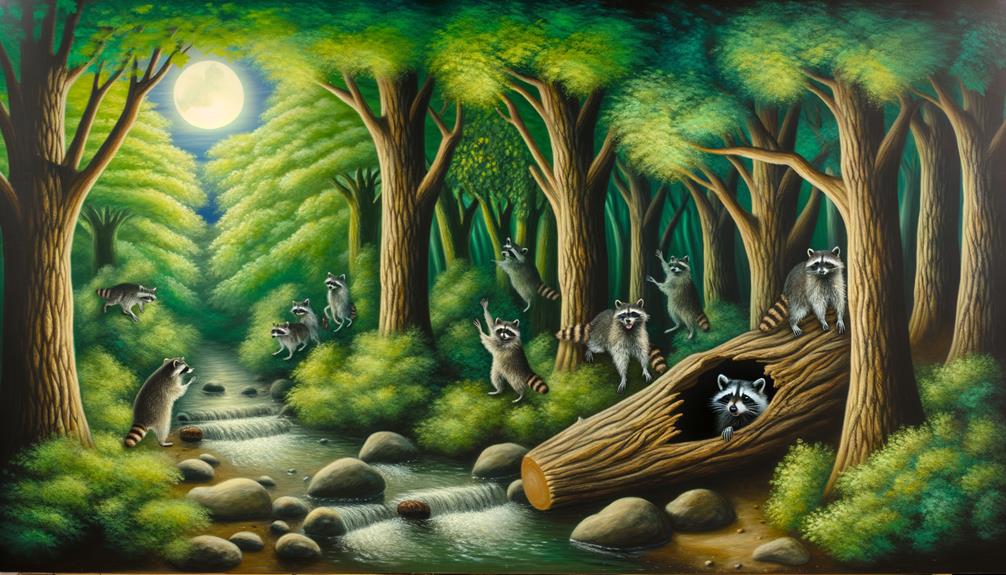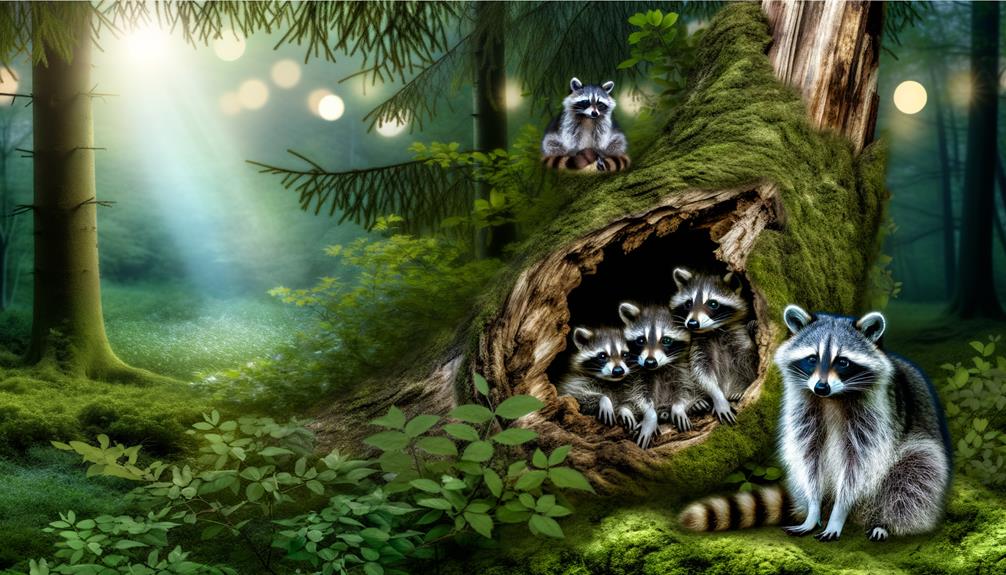Characteristics of the Common Raccoon: A Strategic Insight
The common raccoon (Procyon lotor) is a highly adaptable mammal characterized by its masked facial markings, bushy tail with alternating rings, and dexterous front paws. Weighing between 5-26 kg, raccoons display complex behavior patterns including problem-solving abilities and unique vocalizations.
Preferring deciduous and mixed forests near water bodies, raccoons are omnivorous and exhibit opportunistic foraging. They breed once a year, with a gestation period of approximately 63 to 65 days, and the altricial neonates are dependent on maternal care.
In the wild, their average lifespan is 2 to 3 years. Explore further to understand their intricate behaviors and adaptable nature.

Key Takeaways
- Common raccoons have distinctive masked faces and bushy tails with 5-7 dark rings.
- They exhibit high intelligence with problem-solving abilities and complex behavior patterns.
- Raccoons are highly adaptable, thriving in both urban and natural environments.
- Their diet is omnivorous, consisting of fruits, nuts, insects, and small animals.
- Raccoons breed annually with a gestation period of 63-65 days, producing litters of 2-5 kits.
Essential Traits of the Common Raccoon
| Aspect | Strategic Insight |
|---|---|
| Adaptive Abilities | Raccoons thrive in various habitats, including urban settings, by using their intelligence and resourcefulness. |
| Survival Techniques | Nocturnal behavior helps raccoons avoid many predators, and their ability to climb and swim enhances survival. |
| Omnivorous Diet | A diverse diet allows raccoons to adapt to seasonal changes and environmental availability. |
| Social Structure | Generally solitary, but raccoons can form communal groups for shelter during harsh weather. |
| Communication | Raccoons use complex vocalizations and body language to communicate, particularly during mating and parenting. |
| Reproduction Strategy | Mating in late winter ensures offspring are born in spring, when resources are more abundant for rearing young. |
| Interaction with Humans | Raccoons are opportunistic scavengers, frequently adapting to urban environments, which sometimes leads to conflicts. |
| Predation Evasion | Black face mask and stealthy movement make raccoons harder to spot by predators. |
| Conservation Status | Despite human encroachment, raccoons maintain stable populations due to their adaptability. |
| Resourcefulness | Their ability to open containers and use forepaws for manipulation makes them highly effective foragers. |
Physical Appearance

The common raccoon (Procyon lotor) displays a distinctive physical appearance distinguished by its masked facial markings, bushy tail with alternating rings, and dexterous front paws.
The facial mask, typically black, stands out in contrast with the raccoon’s grayish-brown fur, offering effective camouflage in nocturnal settings.
The tail, usually 20-40 cm in length, showcases 5-7 dark rings that act as a visual identifier.
Adult raccoons weigh between 5-26 kg, with body lengths ranging from 40-70 cm, excluding the tail.
Their front paws, resembling human hands, contain five flexible digits, enabling skilled manipulation of objects.
Dense underfur insulated by guard hairs provides protection against varied environmental conditions.
Importantly, their unique physical traits enhance their adaptability across diverse habitats.
Behavior Patterns
Complementing their distinctive physical features, common raccoons exhibit complex behavior patterns that reflect their high intelligence and adaptability. These nocturnal mammals are primarily solitary, although they may form loose social groups during mating season.
Raccoons display remarkable problem-solving abilities, often manipulating objects with their dexterous front paws. Their foraging behavior is opportunistic, involving a varied diet that includes fruits, nuts, insects, and small vertebrates.
Raccoons are known for their intricate use of vocalizations and body language to communicate. Additionally, they exhibit a unique behavior known as ‘dousing,’ where they dip their food in water before consumption, though the exact reason for this remains a subject of scientific inquiry. These behaviors underscore the raccoon’s ability to thrive in diverse environments.
Natural Habitat

Common raccoons are highly adaptable animals that can inhabit a wide range of environments, from urban areas to forests and wetlands. Their versatility allows them to thrive in both rural and metropolitan settings, including parks, gardens, and suburban backyards.
In natural habitats, raccoons prefer deciduous and mixed forests where dense vegetation provides ample cover. They are also frequently found near water bodies such as rivers, lakes, and marshes, which offer both hydration and food resources.
Urban raccoons often exploit human structures for shelter, utilizing attics, chimneys, and sewers. This adaptability is facilitated by their omnivorous diet and nocturnal habits, enabling them to evade predators and human interference.
Their ability to exploit diverse habitats underscores their ecological resilience.
Diet and Foraging
With their omnivorous diet, raccoons exhibit remarkable dietary flexibility, consuming a diverse array of foods ranging from fruits and nuts to small animals and human refuse.
Their foraging behavior is opportunistic, enabling them to exploit various food sources in both urban and natural environments.
Raccoons are known to forage nocturnally, utilizing their highly developed sense of touch to locate and manipulate food items. They are adept at opening containers, climbing, and even washing their food in water, a behavior believed to enhance tactile sensitivity.
Seasonal variations influence their diet; during autumn, they increase their intake of high-calorie foods to build fat reserves for winter. This dietary adaptability is essential for their survival across diverse habitats.
Reproduction and Lifespan

Raccoons typically breed once a year, with the mating season occurring between January and June, depending on geographic location. Female raccoons experience a gestation period lasting approximately 63 to 65 days, culminating in the birth of litters typically ranging from two to five offspring, known as kits.
Neonatal kits are altricial, being born blind and dependent on maternal care. Weaning occurs around the age of 8 to 10 weeks, though juveniles often remain with the mother until autumn. Raccoons reach sexual maturity at about one year of age.
In the wild, raccoons have an average lifespan of 2 to 3 years, though they can live up to 5 years. In captivity, their lifespan extends significantly, often reaching 10 to 15 years.
Common Raccoon Genus and Species
The common raccoon belongs to the following genus and species:
- Genus: Procyon
- Species: Procyon lotor
This is the scientific classification for the species commonly referred to as the raccoon.
Where are Raccoons Commonly Found
Raccoons (Procyon lotor) are commonly found across a wide range of habitats in North and Central America. Here are some of the key areas where they are prevalent:
North America:
- United States and Canada: Raccoons are abundant throughout much of the United States and southern Canada. They thrive in forests, urban areas, wetlands, and suburban environments.
- Mexico: They are also commonly found in various regions of Mexico.
Central America:
- Raccoons are found in Central American countries such as Guatemala, Belize, and Costa Rica, typically in forested or rural areas.
Islands and Introduced Regions:
- Raccoons have been introduced to parts of Europe (Germany, Russia) and Japan, where they have established breeding populations.
Habitat Preferences:
- Woodlands and Forests: Raccoons prefer habitats near water sources like rivers, lakes, and wetlands, as they are adept at foraging in aquatic environments.
- Urban/Suburban Areas: Raccoons have adapted well to human environments, often living in cities and suburbs, scavenging for food in garbage and finding shelter in attics or other structures.
Their adaptability makes them one of the most widespread mammals in North America.
Conclusion
The common raccoon exhibits a robust adaptability akin to a versatile tool in a survival kit, seamlessly integrating into diverse environments.
Its physical characteristics, nocturnal behavior patterns, and omnivorous diet epitomize ecological flexibility.
This species’ ability to thrive in urban areas, much like a key fitting multiple locks, underscores its resilience.
By understanding the raccoon’s reproductive strategies and lifespan, one can appreciate the intricate balance this species maintains within its ecosystem, contributing to its enduring presence across varied habitats.



